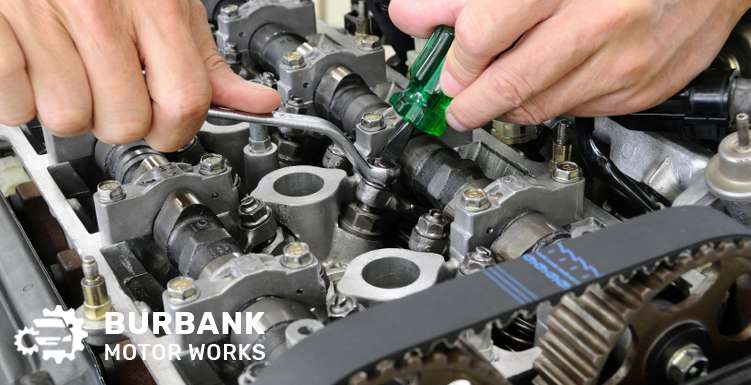
Address: 2208 W Burbank Blvd, Burbank, CA 91506

Mon - Fri: 7:45 Am - 5:30 Pm
Sat: 8:00 Am - 2:30 Pm
Sun: Closed
We'll Be Closed This Sunday – April 20th

Address: 2208 W Burbank Blvd, Burbank, CA 91506

Mon - Fri: 7:45 Am - 5:30 Pm
Sat: 8:00 Am - 2:30 Pm
Sun: Closed
The timing belt is a crucial component of your car’s engine. It might not be something you think about often, but without it, your engine wouldn’t function properly. The timing belt ensures that the engine’s valves open and close at the right time, allowing the engine to run smoothly. If the timing belt wears out or breaks, it can cause serious damage to your engine, leading to costly repairs or even a complete engine replacement.
Understanding the role of the timing belt, as well as how and when to maintain or replace it, is essential for keeping your car in good shape. A well-maintained timing belt ensures that your engine continues to perform efficiently and safely. By following a few key maintenance steps, you can avoid unexpected breakdowns and ensure your car’s engine remains reliable for years to come.

The timing belt is a rubber belt with teeth that synchronizes the movement of the engine’s camshaft and crankshaft. This synchronization ensures that the engine’s valves open and close at the right times during each cycle of the engine.
The timing belt connects the crankshaft, which controls the movement of the pistons, to the camshaft, which controls the opening and closing of the valves. The crankshaft and camshaft must move in perfect harmony for the engine to run smoothly. If the timing is off, the valves won’t open and close properly, which can lead to poor engine performance or even engine damage.
As the timing belt turns, it ensures that the intake and exhaust valves open and close in sync with the movement of the pistons. This precise timing allows air to enter the combustion chamber and exhaust gases to exit, creating the power that moves your car. Without the timing belt, the engine would misfire, stall, or fail to run at all.
A timing belt typically lasts between 60,000 to 100,000 miles, depending on the vehicle. However, it’s important to recognize the signs of wear before it becomes a serious problem.
One common sign of a failing timing belt is a ticking noise coming from the engine. This sound occurs because the timing belt is worn out and no longer maintaining proper tension on the engine’s components. If you hear this noise, it’s important to have your car checked as soon as possible to prevent further damage.
If the timing belt is worn or damaged, it may slip out of alignment, causing the engine’s cylinders to open and close at the wrong time. This misalignment can lead to engine misfires, where the combustion process is disrupted. Engine misfires can cause a loss of power and make the car run rough.
An oil leak near the front of the engine could be a sign that the timing belt cover or its components are worn out. Oil can damage the timing belt, causing it to wear out more quickly. If you notice oil leaking, it’s a good idea to have your timing belt inspected to make sure it’s still in good condition.
If the timing belt is severely worn or broken, your engine may struggle to start or fail to start at all. Without a functioning timing belt, the engine’s components can’t work together, preventing the engine from running. If your car won’t start and you suspect the timing belt is the cause, it’s important to address the issue right away to avoid major engine damage.
Regular maintenance of the timing belt is essential for keeping your car’s engine running smoothly and preventing costly repairs. By following the manufacturer’s recommended maintenance schedule, you can catch issues early and ensure the timing belt is always in good condition.
Every vehicle manufacturer provides guidelines for when to replace the timing belt, usually based on mileage or time. It’s important to follow these recommendations closely, even if your car seems to be running fine. Replacing the timing belt before it breaks can save you from expensive repairs down the road.
During routine maintenance, have a mechanic inspect the timing belt for signs of wear or damage. Look for cracks, fraying, or missing teeth on the belt. If any of these signs are present, it’s time to replace the belt. Catching these issues early can prevent a sudden breakdown or engine damage.
When replacing the timing belt, it’s a good idea to replace related components such as the water pump, tensioners, and pulleys. These parts often wear out at the same time as the timing belt, and replacing them together can save time and money. Plus, it helps ensure the entire system works efficiently.
A failed timing belt can have serious consequences for your car’s engine. In many cases, a broken timing belt can cause the engine to stop running and lead to costly repairs.
In some engines, particularly interference engines, the failure of a timing belt can cause the pistons and valves to collide. This collision can bend or break the valves, damage the pistons, and even crack the engine block. In these cases, repairing the engine can be extremely expensive, and in some cases, it may require a full engine replacement.
If the timing belt breaks while you’re driving, your engine will likely stop running immediately. This can leave you stranded and may cause further damage to other engine components. A sudden breakdown can also be dangerous, especially if it happens on a busy road or highway.
Repairing the damage caused by a failed timing belt can be costly. Depending on the extent of the damage, you may need to replace the valves, pistons, and other engine components. In some cases, it may be more cost-effective to replace the entire engine. To avoid these expensive repairs, it’s essential to replace the timing belt before it fails.

Replacing a timing belt is a complex task that requires special tools and knowledge of your car’s engine. While it’s possible to replace the timing belt yourself if you have mechanical experience, most people choose to have a professional mechanic do the job.
Before replacing the timing belt, make sure you have all the necessary tools and parts, including the new timing belt, water pump (if needed), tensioner, and any seals or gaskets. You’ll also need a timing belt tool kit, which includes the tools required to align the camshaft and crankshaft.
Start by disconnecting the car’s battery to ensure safety while working on the engine. This prevents accidental electrical shock and ensures the engine doesn’t start while you’re working on it.
To access the timing belt, you’ll need to remove several engine components, including the timing belt cover, accessory belts, and possibly the water pump. Carefully label and set aside any bolts or parts you remove to ensure everything is reinstalled correctly.
Once the timing belt is exposed, use the timing belt tool kit to align the camshaft and crankshaft according to the manufacturer’s specifications. This ensures that the engine’s components remain synchronized during and after the belt replacement.
With the camshaft and crankshaft aligned, install the new timing belt. Make sure the belt is properly tensioned and that all components are aligned correctly. Replace any related parts, such as the tensioner or water pump, if needed.
Once the new timing belt is in place, reassemble the engine by reinstalling the timing belt cover, accessory belts, and any other components you removed. Reconnect the battery, and start the engine to ensure everything is working properly.
Maintaining the timing belt system is key to ensuring your car’s engine runs smoothly and efficiently. By following these maintenance tips, you can extend the life of your timing belt and prevent unexpected issues.
Over time, the timing belt can lose tension, which can cause it to slip or wear out more quickly. Have a mechanic check the tension regularly to ensure the belt is properly tightened.
A clean engine is less likely to experience timing belt issues. Dirt, oil, and debris can damage the timing belt, so make sure your engine is cleaned regularly during routine maintenance.
Pay attention to any changes in engine performance, such as ticking noises, misfires, or difficulty starting. These could be signs of a worn timing belt and should be checked by a mechanic as soon as possible.
The timing belt plays an essential role in the function of your car’s engine. Without it, the engine’s components wouldn’t be able to work together, and the engine would quickly fail. By understanding how the timing belt works, recognizing the signs of wear, and following a regular maintenance and replacement schedule, you can keep your car running smoothly and avoid costly repairs. Taking care of your timing belt ensures that your engine remains reliable and safe for years to come.
Timing belts typically need to be replaced every 60,000 to 100,000 miles, depending on the vehicle and manufacturer’s recommendations. Always follow the manufacturer’s guidelines for the best results.
Driving with a worn timing belt is risky. If the belt breaks, it can cause severe engine damage, potentially leaving you stranded and needing expensive repairs. It’s best to replace it before it fails.
If the timing belt slips, the engine’s camshaft and crankshaft will become misaligned, causing poor engine performance. This can lead to misfires, loss of power, and possible engine damage if not fixed.
Yes, it’s a good idea to replace the water pump when replacing the timing belt, especially if the pump is driven by the belt. Replacing both at the same time can save labor costs and prevent future issues.
Call us for booking an early appointment and get all your car related problems solved by our experts.